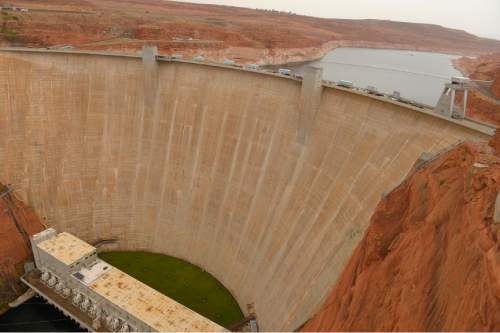This is an archived article that was published on sltrib.com in 2016, and information in the article may be outdated. It is provided only for personal research purposes and may not be reprinted.
For the third time, economists from the University of Utah have offered their independent analysis of financing a $1.3 billion-$1.7 billion pipeline to carry water from Lake Powell to St. George. And for the third time, the analysis shows it isn't practical to think the people who would use that water can actually cover that cost by themselves.
The economists say that means the bill will go all Utahns, the vast majority of whom won't be served by the pipeline.
One scenario coming out of the Washington County Water Conservancy District indicated it could cover the total costs with an additional charge of 28 cents per 1,000 gallons from the district's customers and an increase in impact fees for new construction.
But the 17 U. economics faculty members who sent a recent letter to the governor and legislators aren't buying that. They say that figure would barely cover a quarter of the costs, meaning the state would cover the other three-quarters. If the district's customers really did have to cover the full costs, the economists say they'll be hit with something in the neighborhood of a 500 percent increase in water rates.
For its part, the district is distancing itself from that 28-cent figure and the assumptions it is based on, which they say just came from a "focus group exercise."
"The decision to build the pipeline hasn't been made yet," a district spokeswoman said. "We get caught up in the details when we need to take a step back and see this is preliminary research into whether this is the best project for Utah."
The district is trying to separate the decision on whether to build the pipeline from the decision of how to pay for it. That is absurd. Everything requires a cost-benefit analysis, and part of that is figuring out who shoulders the costs.
Let's be clear. The pipeline is not a necessity. Washington County is certain to grow in population, but that growth will also chew up farmland, meaning that water now going to agriculture will become available.
And there is a lot of agricultural water down there. The pipeline would pull 86,000 acre feet of water from Lake Powell, but there are already 125,000 acre feet of existing water now dedicated to agriculture. One acre foot will grow a crop of alfalfa on one acre, or it could supply a family of four for a year. On top of that, Washington County has arguably the highest per capita water consumption in the nation. Just lowering that to Las Vegas' consumption level would free up thousands more acre-feet.
Instead of continually deflecting others' figures, it's time for the water districts (and their supporters in the state Legislature) to detail exactly how the financing will work. Not a focus group exercise. A real, and realistic, plan for paying for this. That should happen before this idea goes any further.



